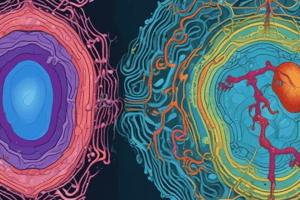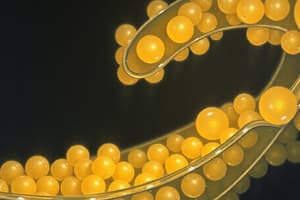Podcast
Questions and Answers
What type of proteins facilitate the massive diffusion in plant and animal cells?
What type of proteins facilitate the massive diffusion in plant and animal cells?
- Aquaporins (correct)
- Ion channels
- Gated channels
- Carrier proteins
Which type of channel proteins open or close in response to a stimulus?
Which type of channel proteins open or close in response to a stimulus?
- Gated channels (correct)
- Carrier proteins
- Ion channels
- Aquaporins
Without the high number of aquaporins in certain kidney cells, what would be the consequence in terms of urine production?
Without the high number of aquaporins in certain kidney cells, what would be the consequence in terms of urine production?
- Excreting about 180 L of urine per day (correct)
- Requiring more food intake
- Having to drink less water
- Reclaiming less water from urine
Which type of proteins seem to change shape to translocate the solute-binding site across the membrane?
Which type of proteins seem to change shape to translocate the solute-binding site across the membrane?
What type of transport protein brings about a tremendous increase in the rate of water molecules passing through the cell membrane?
What type of transport protein brings about a tremendous increase in the rate of water molecules passing through the cell membrane?
Which type of transport protein holds onto its passengers and changes shape to shuttle them across the membrane?
Which type of transport protein holds onto its passengers and changes shape to shuttle them across the membrane?
What determines the selectivity of a carrier protein in transporting substances across the membrane?
What determines the selectivity of a carrier protein in transporting substances across the membrane?
Which molecules can cross a lipid bilayer without the assistance of membrane proteins, as mentioned in the text?
Which molecules can cross a lipid bilayer without the assistance of membrane proteins, as mentioned in the text?
Why is a transport protein needed to move water molecules rapidly and in large quantities across a membrane?
Why is a transport protein needed to move water molecules rapidly and in large quantities across a membrane?
Based on the text, what is the main function of aquaporins?
Based on the text, what is the main function of aquaporins?
What is the basis of the selectivity that allows some aquaporins to exclude hydronium ions but allow glycerol and water molecules to pass?
What is the basis of the selectivity that allows some aquaporins to exclude hydronium ions but allow glycerol and water molecules to pass?
What happens in the process of diffusion when two solutions reach dynamic equilibrium?
What happens in the process of diffusion when two solutions reach dynamic equilibrium?
Flashcards are hidden until you start studying
Study Notes
Protein-Mediated Transport
- Channel proteins facilitate massive diffusion in plant and animal cells.
- Ligand-gated channel proteins open or close in response to a stimulus.
Aquaporins and Urine Production
- Aquaporins are responsible for transporting water molecules across the cell membrane.
- Without a high number of aquaporins in certain kidney cells, urine production would decrease.
Carrier Proteins
- Carrier proteins seem to change shape to translocate the solute-binding site across the membrane.
- Carrier proteins bring about a tremendous increase in the rate of solute transport across the membrane.
Transport Mechanisms
- Transport proteins are needed to move water molecules rapidly and in large quantities across a membrane because the lipid bilayer is impermeable to water.
- Some transport proteins hold onto their passengers and change shape to shuttle them across the membrane.
Selectivity of Carrier Proteins
- The selectivity of a carrier protein in transporting substances across the membrane is determined by the shape and chemistry of the binding site.
- Some aquaporins exclude hydronium ions but allow glycerol and water molecules to pass due to the basis of their selectivity.
Diffusion and Dynamic Equilibrium
- In the process of diffusion, when two solutions reach dynamic equilibrium, the movement of molecules from one solution to another becomes equal in both directions.
- Small molecules, such as oxygen and carbon dioxide, can cross a lipid bilayer without the assistance of membrane proteins.
Studying That Suits You
Use AI to generate personalized quizzes and flashcards to suit your learning preferences.




